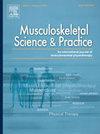A comparison of the characteristics of physically active and inactive individuals with Greater Trochanteric Pain Syndrome: An online survey
IF 2.2
3区 医学
Q1 REHABILITATION
引用次数: 0
Abstract
Objective
To compare the characteristics of physically active and inactive individuals with Greater Trochanteric Pain Syndrome (GTPS) and to explore factors associated with disability.
Design
Cross-sectional on-line survey.
Methods
Adults aged ≥18 years with lateral hip pain participated in an online survey. Comparisons were made between active individuals (≥150 min/week of physical activity) and inactive individuals (<150 min/week of physical activity). Disability was measured using the Victoria Institute of Sports Assessment-Gluteal (VISA-G) and psychological factors with the Tampa Scale for Kinesiophobia (TSK) and Hospital Anxiety and Depression Scale (HADS). Number of pain sites (1–30) and self-reported body weight were also evaluated. Chi-squared (Chi2) and Mann-Whitney U tests determined group differences. Multiple linear regression identified characteristics associated with disability.
Results
261 individuals with self-reported GTPS responded. 209 (80 %) were physically active and 52 (20 %) inactive. Inactive individuals had higher disability (39 vs. 65 points) (p < 0.001), higher number of pain sites (median 5, IQR 3–7) vs (3,2–5) (p < 0.001) and were more likely to consider themselves overweight (65.4 % vs 29.7 %) (p < 0.001) compared to active individuals. No differences were observed for kinesiophobia, anxiety or depression between groups. Eighty per cent of disability was explained by physical activity level, pain intensity during activity, kinesiophobia, depression, body weight status and sleep disturbance.
Conclusion
Physically inactive individuals with GTPS exhibit higher disability, a higher number of pain sites and were more likely to consider themselves overweight compared to active individuals. Physical and psychological factors were associated with disability.
大转子疼痛综合征患者体力活动与不活动个体特征的比较:一项在线调查
目的比较运动与不运动大转子痛综合征(GTPS)患者的特征,探讨与残疾相关的因素。设计横断面在线调查。方法年龄≥18岁的髋关节外侧疼痛患者参与在线调查。比较运动个体(≥150分钟/周体力活动)和不运动个体(<;150分钟/周体力活动)。使用维多利亚运动评估-臀肌(VISA-G)和坦帕运动恐惧症量表(TSK)和医院焦虑和抑郁量表(HADS)的心理因素来测量残疾。疼痛部位数(1-30)和自我报告的体重也进行了评估。卡方检验(Chi2)和Mann-Whitney U检验确定了组间差异。多元线性回归确定了与残疾相关的特征。结果261名自述GTPS患者有应答。209人(80%)有运动,52人(20%)没有运动。不运动个体的残疾程度更高(39比65分)(p <;0.001),疼痛部位数量(中位数5,IQR 3 - 7)高于(3,2 - 5)(p <;0.001),更有可能认为自己超重(65.4% vs 29.7%) (p <;0.001)。在运动恐惧症、焦虑或抑郁方面,两组之间没有观察到差异。80%的残疾可以用身体活动水平、活动时的疼痛强度、运动恐惧症、抑郁、体重状况和睡眠障碍来解释。结论与积极运动的个体相比,缺乏运动的GTPS个体表现出更高的残疾程度、更多的疼痛部位,并且更有可能认为自己超重。生理和心理因素与残疾有关。
本文章由计算机程序翻译,如有差异,请以英文原文为准。
求助全文
约1分钟内获得全文
求助全文
来源期刊

Musculoskeletal Science and Practice
Health Professions-Physical Therapy, Sports Therapy and Rehabilitation
CiteScore
4.10
自引率
8.70%
发文量
152
审稿时长
48 days
期刊介绍:
Musculoskeletal Science & Practice, international journal of musculoskeletal physiotherapy, is a peer-reviewed international journal (previously Manual Therapy), publishing high quality original research, review and Masterclass articles that contribute to improving the clinical understanding of appropriate care processes for musculoskeletal disorders. The journal publishes articles that influence or add to the body of evidence on diagnostic and therapeutic processes, patient centered care, guidelines for musculoskeletal therapeutics and theoretical models that support developments in assessment, diagnosis, clinical reasoning and interventions.
 求助内容:
求助内容: 应助结果提醒方式:
应助结果提醒方式:


